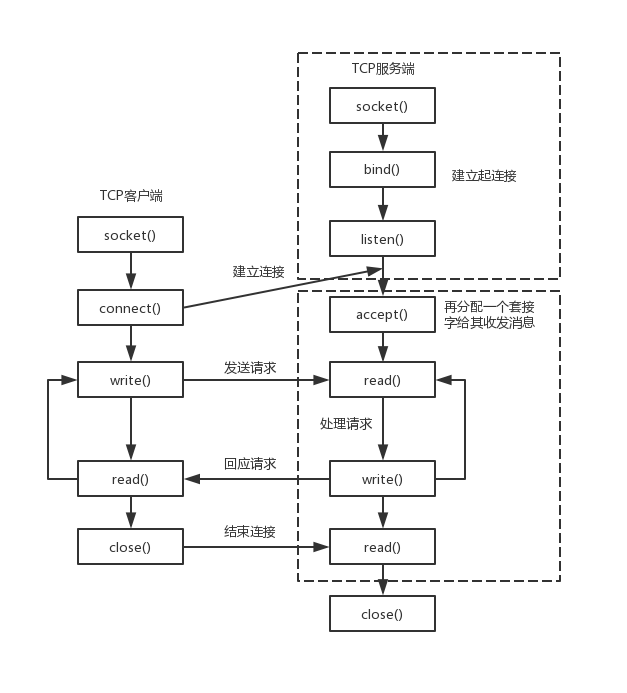asio
- 网络编程的基本流程
- [创建 socket](#创建 socket)
- 绑定acceptor
- 连接指定的端点
- 服务器接受连接
网络编程的基本流程
- 服务端
1)socket----创建socket对象。
2)bind----绑定本机ip+port。
3)listen----监听来电,若在监听到来电,则建立起连接。
4)accept----再创建一个socket对象给其收发消息。原因是现实中服务端都是面对多个客户端,那么为了区分各个客户端,则每个客户端都需再分配一个socket对象进行收发消息。
5)read、write----收发消息
- 客户端
1)socket----创建socket对象。
2)connect----根据服务端ip+port,发起连接请求。
3)write、read----建立连接后,就可发收消息了

创建 socket
创建socket分为4步,创建上下文iocontext,选择协议,生成socket,打开socket。
cpp
int create_tcp_socket() {
// Step 1. An instance of 'io_service' class is required by
// socket constructor.
asio::io_context ios;
// Step 2. Creating an object of 'tcp' class representing
// a TCP protocol with IPv4 as underlying protocol.
asio::ip::tcp protocol = asio::ip::tcp::v4();
// Step 3. Instantiating an active TCP socket object.
asio::ip::tcp::socket sock(ios);
// Used to store information about error that happens
// while opening the socket.
boost::system::error_code ec;
// Step 4. Opening the socket.
sock.open(protocol, ec);
if (ec.value() != 0) {
// Failed to open the socket.
std::cout
<< "Failed to open the socket! Error code = "
<< ec.value() << ". Message: " << ec.message();
return ec.value();
}
return 0;
}上述socket只是通信的socket,如果是服务端,我们还需要生成一个acceptor的socket,用来接收新的连接。
cpp
int create_acceptor_socket() {
// Step 1. An instance of 'io_service' class is required by
// socket constructor.
asio::io_context ios;
// Step 2. Creating an object of 'tcp' class representing
// a TCP protocol with IPv6 as underlying protocol.
asio::ip::tcp protocol = asio::ip::tcp::v6();
// Step 3. Instantiating an acceptor socket object.
asio::ip::tcp::acceptor acceptor(ios);
// Used to store information about error that happens
// while opening the acceptor socket.
boost::system::error_code ec;
// Step 4. Opening the acceptor socket.
acceptor.open(protocol, ec);
if (ec.value() != 0) {
// Failed to open the socket.
std::cout
<< "Failed to open the acceptor socket!"
<< "Error code = "
<< ec.value() << ". Message: " << ec.message();
return ec.value();
}
return 0;
}绑定acceptor
对于acceptor类型的socket,服务器要将其绑定到指定的端口,所有连接这个端口的连接都可以被接收到。
cpp
int bind_acceptor_socket() {
// Step 1. Here we assume that the server application has
// already obtained the protocol port number.
unsigned short port_num = 3333;
// Step 2. Creating an endpoint.
asio::ip::tcp::endpoint ep(asio::ip::address_v4::any(),
port_num);
// Used by 'acceptor' class constructor.
asio::io_context ios;
// Step 3. Creating and opening an acceptor socket.
asio::ip::tcp::acceptor acceptor(ios, ep.protocol());
boost::system::error_code ec;
// Step 4. Binding the acceptor socket.
acceptor.bind(ep, ec);
// Handling errors if any.
if (ec.value() != 0) {
// Failed to bind the acceptor socket. Breaking
// execution.
std::cout << "Failed to bind the acceptor socket."
<< "Error code = " << ec.value() << ". Message: "
<< ec.message();
return ec.value();
}
return 0;
}连接指定的端点
作为客户端可以连接服务器指定的端点进行连接
cpp
int connect_to_end() {
// Step 1. Assume that the client application has already
// obtained the IP address and protocol port number of the
// target server.
std::string raw_ip_address = "127.0.0.1";
unsigned short port_num = 3333;
try {
// Step 2. Creating an endpoint designating
// a target server application.
asio::ip::tcp::endpoint
ep(asio::ip::address::from_string(raw_ip_address),
port_num);
asio::io_context ios;
// Step 3. Creating and opening a socket.
asio::ip::tcp::socket sock(ios, ep.protocol());
// Step 4. Connecting a socket.
sock.connect(ep);
// At this point socket 'sock' is connected to
// the server application and can be used
// to send data to or receive data from it.
}
// Overloads of asio::ip::address::from_string() and
// asio::ip::tcp::socket::connect() used here throw
// exceptions in case of error condition.
catch (system::system_error& e) {
std::cout << "Error occured! Error code = " << e.code()
<< ". Message: " << e.what();
return e.code().value();
}
}服务器接受连接
cpp
int accept_new_connection(){
// The size of the queue containing the pending connection
// requests.
const int BACKLOG_SIZE = 30;
// Step 1. Here we assume that the server application has
// already obtained the protocol port number.
unsigned short port_num = 3333;
// Step 2. Creating a server endpoint.
asio::ip::tcp::endpoint ep(asio::ip::address_v4::any(),
port_num);
asio::io_context ios;
try {
// Step 3. Instantiating and opening an acceptor socket.
asio::ip::tcp::acceptor acceptor(ios, ep.protocol());
// Step 4. Binding the acceptor socket to the
// server endpint.
acceptor.bind(ep);
// Step 5. Starting to listen for incoming connection
// requests.
acceptor.listen(BACKLOG_SIZE);
// Step 6. Creating an active socket.
asio::ip::tcp::socket sock(ios);
// Step 7. Processing the next connection request and
// connecting the active socket to the client.
acceptor.accept(sock);
// At this point 'sock' socket is connected to
//the client application and can be used to send data to
// or receive data from it.
}
catch (system::system_error& e) {
std::cout << "Error occured! Error code = " << e.code()
<< ". Message: " << e.what();
return e.code().value();
}
}